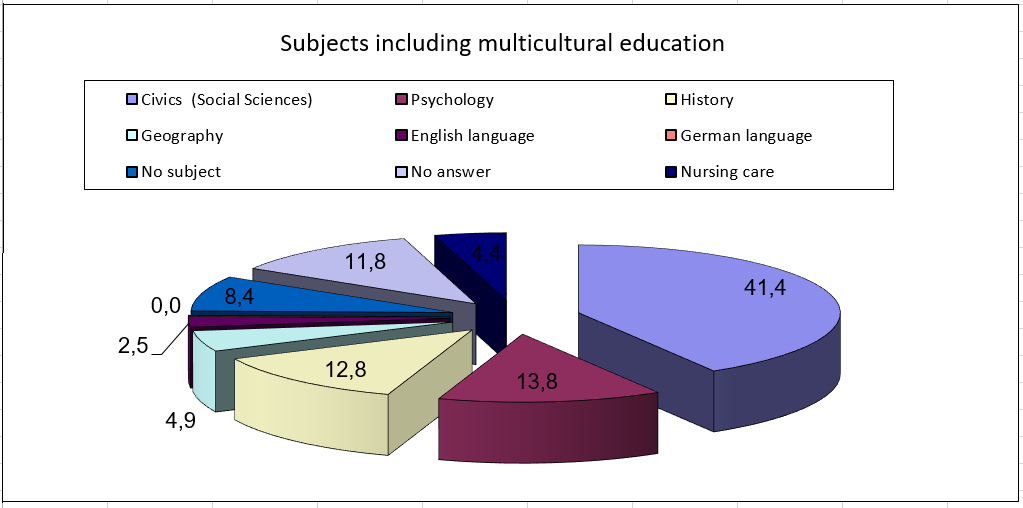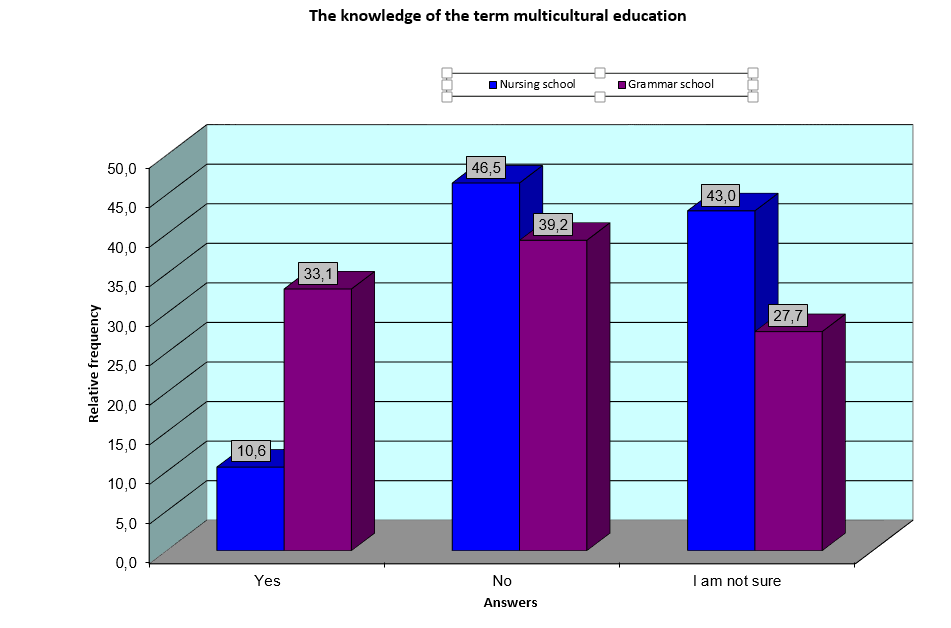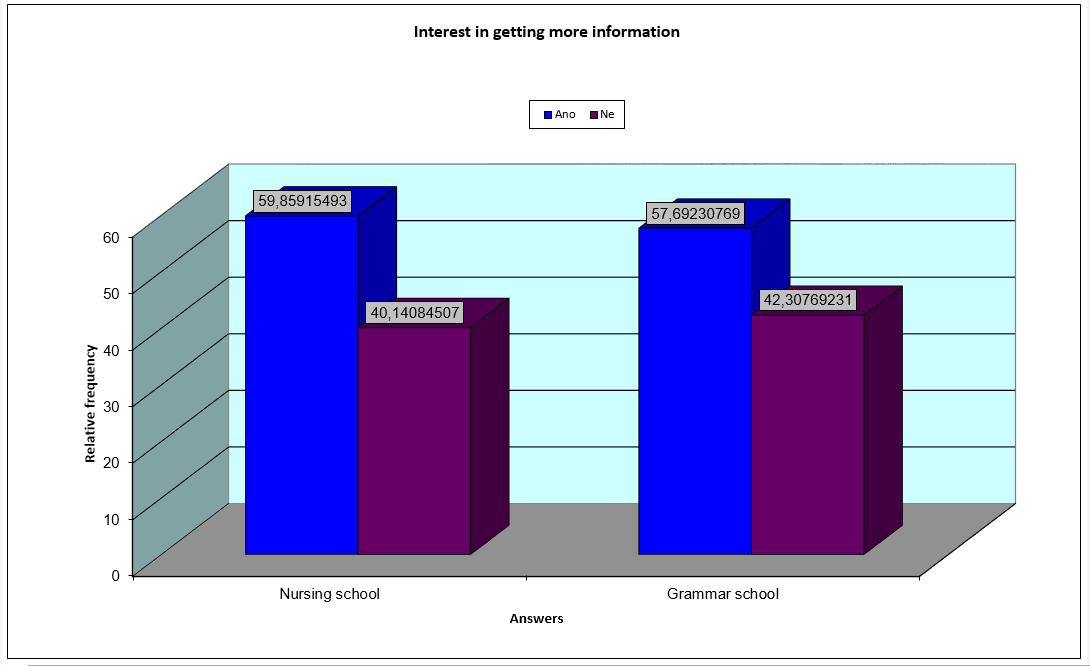Abstract
The Czech Republic had 10,597,473 inhabitants as of September 30, 2017. Based on available data there were 493,441 foreigners with permanent residency living here as of December 31, 2016, and 221,484 with a long stay permit over 90 days. There is an increasing number of foreigners who were born in the Czech Republic – 3,709 in 2016, which is three times as many as in 2002. Most foreigners come from Ukraine, Slovakia, and Vietnam. If children in the Czech Republic are to grow up in a culturally tolerant environment, then it is necessary to prepare the future generations of teachers for that, including kindergarten teachers, as early as in high schools. Our research was conducted between 2014 and 2015 in specialized professional schools and prep schools. The goal of this research study was to establish the following: 1) How, and 2) in what subjects are students educated in multiculturalism, and 3) whether they are satisfied with this offer. Methods: The research was conducted in the form of a 16-item questionnaire. 272 fully filled out questionnaires were considered to be 100%. Results: In professional schools students get information in history, philosophy and psychology lessons. In prep schools they get a lot of information during language lessons, especially English, as it is mandatory. Conclusion: In Czech high schools students get information regarding multiculturalism in various subjects. There is no specialized subject focused on multiculturalism in any Czech high schools. A vast majority of students do not even know what the term means
Keywords: Multiculturalismupbringingstudentseducation
Introduction
Many professions including kindergarten teachers, elementary school teachers, health care professionals – especially nonmedical health care professions – are expected in the long run to educate their students to understand various cultural manifestations and standpoints. All these professionals should have adequate knowledge in the field of multicultural studies, and a personality capable of empathy and understanding (Pacovský, 2001; Kutnohorská, 2013). Knowledge of culture (traditions, customs, cultural stereotypes) communication culture should be at a high level because communication is of utmost importance. It can help a lot but hurt a lot as well.
Cultural diversity is one of the central signs of cultural progress. Culture, as well as multiculture, are always social, developing among people who are extremely sensitive to multicultural ethics, including communication ethics (Kutnohorská, 2004; Kutnohorská, 2007; Mastiliaková, 2007).
As the number of foreigners living in the Czech Republic has been increasing by the year, and it has almost doubled in the past ten years, it is desirable that those who have contact with children from a different cultural setting – be it in school or in hospital – were empathic to all the specific manifestations of cultural traditions and customs (Ivanová, Špirudová & Kutnohorská, 2005; Špirudová, Tomanová, Kudlová & Halmo, 2005). We should pay special attention especially to multicultural education, a part of which is the question of multicultural communication, as it is communication that gives rise to a huge risk of misunderstanding (Průcha, 2001).
Statistical data
The foreign-born population living legally in the Czech Republic had increased the most between 2005 and 2009 (by 63%). At the same time the number of children born to foreigners living in the Czech Republic had doubled between 2005 and 2009, making the per capita percentage today one of the highest among post-communist countries in Europe. Most foreigners come from Ukraine, Slovakia, and Vietnam. As of July 1, 2005 266,303 foreigners were registered in the Czech Republic. Their number had gone up to 435,034 four years later. (Cizinci v České republice, 2017, Online; Czech Statistical Office; Population). Between 2009 and 2016 this number had not increased much. As of December 31, 2016 (which is the most up-to-date data today) the number of foreign-born population (including their Czech-born children) was 496,413. This number includes foreigners who have one of the following: permanent residence, long-term residence and long-term visa, temporary residence for EU citizens, and this number also includes 2,972 asylum applicants (Cizinci v České republice, 2018, Online; CSO. Population) (Marešová, 2017) (Czech Ministry of Foreign, Online).
Traditionally, the most foreigners come from Ukraine (110,245 persons), Slovakia (107,251), and Vietnam (58,080). These countries' citizens made up for 55.5% of foreigners legally living (or registered) in the Czech Republic. The ranking has not changed much over the last few years. Russians (35,987) were in fourth place in 2016, followed by Germans (21,216), Poles (20,305), Bulgarians (12,250), Romanians (10,826), Americans (8,763), and UK citizens (6,288) (Marešová, 2017).
Based on the Education Department's data there were a total of 362,653 children attending kindergartens in the Czech Republic, out of whom 2.6% (9,494) were children of foreigners, and 5,971 (62.9%) children out of these 9,494 were European-born (2,712 of them from EU member states). Children who are non-European citizens make up for 37.1% among foreign-born kindergarten children. In the past ten years the numbers of foreign-born children attending a kindergarten in the Czech Republic have more than tripled: from 3,078 in the 2007/2008 school year to 9,494 in the 2016/2017 one (Marešová, 2017).
In terms of citizenship, children from third countries have a majority among children-foreigners in kindergartens. In the 2016/2017 school year they accounted for 71.4% of foreigners attending kindergartens. These are mainly Vietnames citizens (26.9% of the total number of foreigners in kindergartens in the 2016/2017 school year), Ukraine (23.7%), and Russia (6.2%). Slovak citizens have a majority among foreigners from the EU (18.1%) (Kudlová & Krajcová 2015).
The past 10 years have seen a significant increase in namely Ukrainian citizens. The number of these foreign nationals had increased from fewer than 600 in the 2007/2008 school year to 2,254 in 2016/2017. Children-foreigners in kindergartens (93.7%) reside in the Czech Republic based on permanent residence permit (Marešová, 2017).
Data from the Education Department suggest that a total of 906,188 elementary school students were registered in the Czech Republic, 2.2% of them being foreigners. A total of 6,549 students (i.e. 32.4% out of the total of 20,237 foreigners) were from a member state of the E.U. The remaining 13,688 persons were students from third countries, mostly from non E.U. European countries (7,791). Based on annual comparison it is obvious that the number of students-foreigners had increased dramatically in the 2016/2017 school year. This group of elementary school students-foreigners had grown by 1,272 persons. Contrary to this, the number of foreigners from the 28 E.U. countries had only increased by 684 people between 2015/2016 – 2016/2017. If we look back on a longer period of time (the past ten years) it is clear that the number of foreigners in elementary schools had significantly increased from 12,963 in the 2007/2008 school year to 20,237 persons in 2016/2017). Thus the percentage of foreigners out of the total number of elementary school students had increased from 1.5% to 2.2%. Just like in case of children-foreigners attending kindergartens, foreigners attending elementary schools had seen a significant increase, too. Third country citizens have a majority among foreigners attending elementary schools. Ukrainian citizens have the highest percentage (26.3%) of the total number of foreigners attending elementary schools, followed by Vietnam (19.8%), and Russia (7.3%). Slovak citizens are the largest group among the 28 E.U. member states (22.3%) (Marešová, 2017).
Rights and powers of foreigners in the Czech Republic
In terms of elementary, secondary and college education, foreigners have the same rights and duties as the citizens of the Czech Republic. Foreigners have the right to receive education based on the Charter of Fundamental Human Rights and Freedoms. Persons who have the right to reside in the Czech Republic for 90 days or longer, or are authorized to reside in the territory of the Czech Republic in order to conduct research, or seek asylum as persons enjoying complementary protection, applicants applying for international protection, or persons enjoying temporary protection have access to pre-school, elementary, artistic and linguistic education under the same conditions as the citizens of the Czech Republic and member states of the E.U.
Education of foreigners is stipulated by the directives of the Education Department of the Czech Republic:
Act 561/2004 Coll. on pre-school, elementary, secondary, tertiary professional and other education (the Education Act), in which a separate article deals with education of foreigners.
Directive of the Education Department from 2000 to provide Czech courses for asylum seekers.
The Universities Act, and that of change and amendment of other laws (The Universities Act).
Problem Statement
The goal of our research was to get an idea whether high school graduates are adequately educated in multicultural studies, whether they feel the need to be educated in the field of multiculturalism, so that we could specify this discipline in bachelor's programs, and not offer students redundant knowledge.
Research Questions
-
How are high school students educated in multiculturalism?
-
In which subjects do high school students learn the most about other nations and their cultures, traditions and customs?
-
Whether they consider the offer of education in multiculturalism as adequate?
Purpose of the Study
Based on our research we compared students of professional schools (nursing school) to those of prep schools. We were namely interested in which subjects the students learned the most about other nations, their cultures, traditions, customs, family functioning, etc. Do they consider the offer of education in multiculturalism as adequate?
Research Methods
Participants
The respondents were high school students (nursing school and prep schools), the reason for this purposeful selection being the fact that it is this age when students form their cultural standpoints and the ability to tolerate other cultures besides their own.
I Instruments and methodology
The quantitative method was chosen for the research – a questionnaire containing 16 questions of our own construction. These were derived from our experience with previously realized research studies since 2002 in mutual collaboration at Ostrava University in Ostrava and Palacky University in Olomouc. A total of 300 students were asked to partake in this research, but eventually 272 questionnaires were considered 100%. This research study took place between 2014 and 2015, and its results are still valid;
Findings
The research has shown that students do meet foreign nationals, mostly the Vietnamese. In nursing schools students acquire multiculturalism related knowledge in the following subjects (ranked first to last based on the number of answers): history, social sciences, nursing, and psychology (Figure

According to Kutnohorská (2013) multicultural competence should be an integral part of every nurse´s and every healthcare professional´s personality. These are a benefit if a part of one´s personality, and are acquired via systemic studying of cultures (Kutnohorská, 2013).
The research has found that multicultural education is known to 10.6% of nursing schools respondents out of the total of students asked, whereas 46.6% do not know the term at all, the others are not sure. In prep schools the term of multicultural education is known to 33.1% of the total number of students asked, 39.2% do not know this term, and the others are not sure (Figure

More than a half of the respondents would welcome more information about multiculturalism (Figure

Conclusion
Students mentioned that they were going to use the knowledge of other cultures' customs and traditions while traveling abroad. They pay no attention to the fact that the Czech Republic has the highest percentage of foreigners among all the post-communist countries, and that they will be meeting them in both their work and private lives. Every situation has cultural, social and political dimensions. These do not only mean ethical duty but should be an appeal to support health and education toward health. Every culture and every ethnic group has its own notion of what they consider normal behavior. Only a creative person who is prepared for future changes will be able to face dilemmatic situations that may arise in practice (Kolektiv 2002, 2005; Hajisoteriou, Karousiou & Angelides, 2018; GENE Website, Online).
Our common goal is to teach them to live in a multicultural society, which includes a number of different sociocultural groups. Coexistence with members of minorities must be based on the principles of tolerance, respect, dialog, and constructive collaboration. The tool for this is multicultural education (Průcha, 2001) (Kutnohorská & Kudlová, 2016).
The need for multicultural education within the education system is rooted in the constitutional concept of the Czech Republic. However, it started to be urgently emphasized due to difficulties in coexistence with other ethnicities in the late 1990s. Efforts to prevent manifestations of xenophobia and intolerance led to the passing of many legislative, regulatory and social measures meant to improve the relationship between the majority population and minorities. International migration has dual meaning for the Czech Republic: it affects the number of population at a time when the number of Czech population is decreasing, and it is an important part of the workforce at a time of growing unemployment. Cultural diversity is a characteristic feature of Europe. Certain locations may have different features and problems, however, they all share unique typical signs of the location and identity
Acknowledgments
We thank students and schools for their participation in the research.
References
- (2017). Cizinci v republice [Online].
- (2017). Cizinci v republice (zveřejněno 27. 11.. [Online]., 43, 2018-02
- Angelides, P. (2018). Successful components of school improvement in culturally diverse schools.. School Effectiveness and School Improvement,, 43, 91-112
- Ivanová, K.Špirudová, L.Kutnohorská, J. (2005). Multikulturní ošetřovatelství I. Praha: Grada. ISBN, 80-247
- Kolektiv, . (2002). Komunikace s při zdravotní péče a jejich transkulturní / multikulturní odlišnosti v českého právního řádu. Ostrava: Repronis.. ISBN, 80-7042
- Kolektiv, . (2005). Česká společnost na prahu vstupu do Evropské unie: podpora multikulturního ošetřovatelského přístupu v celoživotním zdravotnickém vzdělávání. Ostrava: Zdravotně sociální fakulta Ostravské univerzity, 209 s.. ISBN, 80-7042
- Kudlová, P.Krajcová, T. (2015). Assimilation of the russian minority into the majority population in the Czech Republic as seen from the viewpoint of nursing - pilot study.. Zdravotnícke listy,, 43(2), 24-29
- Kutnohorská, J.Kudlová, P. (2016). Dignity of Man - Theoretical Recources. Zdravotnické listy,, 43(1), 56-60
- Kutnohorská, J. (2013). Multikulturní ošetřovatelství pro praxi.. Praha: Grada. ISBN, 978-80
- Kutnohorská, J. (2007). Filozofie a etika multikulturalismu. s. 4-14. In: Mastiliaková D. a Implementace multikulturní variability do kulturní identity české společnosti a její odraz ve zdravotnické praxi. Opava: Slezská univerzita.. ISBN:, 978-80
- Kutnohorská, J. (2004). Etika v ošetřovatelském přístupu. s. 80-92. In: Kolektiv, Česká společnost na prahu vstupu do Evropské unie a její odraz ve zdravotnické praxi. Podpora multikulturního ošetřovatelského přístupu v zdravotnickém vzdělávání. Ostrava: Repronis.. ISBN, 80-7042
- Mastiliaková, D a kol. (2007). Implementace multikulturní variability do kulturní identity české společnosti a její odraz ve zdravotnické praxi: Podpora multikulturního ošetřovatelského přístupu v celoživotním zdravotnickém vzdělávání u nelékařských oborů. Opava: Slezská univerzita v Opavě.. ISBN, 978-80
- Marešová, J. (2017). Život cizinců v Praha: Český statistický úřad. Prosinec
- Průcha, J. (2001). Multikulturní výchova. Praha: ISV nakladatelství. ISBN, 978-80
- Špirudová, L.Tomanová, D.Kudlová, P.Halmo, R. (2005). Multikulturní ošetřovatelství II.. Grada., 80-247
Copyright information

This work is licensed under a Creative Commons Attribution-NonCommercial-NoDerivatives 4.0 International License.
About this article
Publication Date
13 July 2018
Article Doi
eBook ISBN
978-1-80296-042-6
Publisher
Future Academy
Volume
43
Print ISBN (optional)
-
Edition Number
1st Edition
Pages
1-694
Subjects
Child psychology, developmental psychology, child care, child upbringing, family psychology
Cite this article as:
Kudlová, P., & Kutnohorská, J. (2018). Preparation Of High School Students In The Area Of Multiculturalism. In S. Sheridan, & N. Veraksa (Eds.), Early Childhood Care and Education, vol 43. European Proceedings of Social and Behavioural Sciences (pp. 430-437). Future Academy. https://doi.org/10.15405/epsbs.2018.07.56

